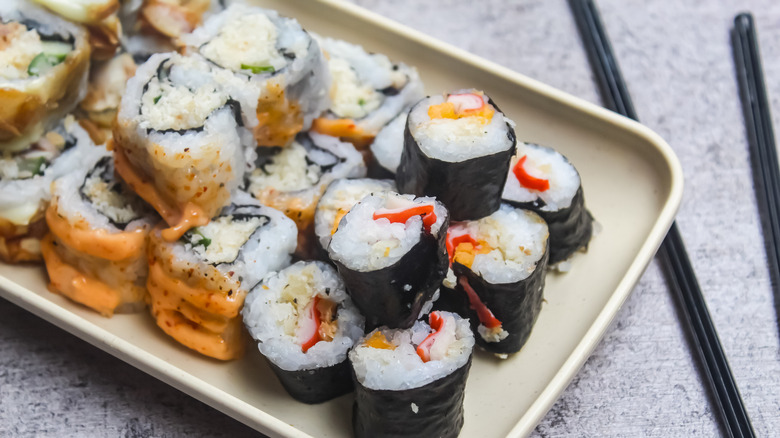What's The Difference Between Quinoa And Rice?
It's not uncommon for quinoa and rice to show up next to each other on menus and in recipes where you need a substitute. However, they're actually not always interchangeable and they're definitely not the same thing. It's true that you can easily use both for the role of a hearty base in grain bowls, stir-fries, and salads. The difference between quinoa and rice starts with biology. Quinoa isn't a grain — it's a seed from a flowering plant in the amaranth family. Rice is a true cereal grain, grown from grasses and cultivated for thousands of years across Asia and other parts of the world.
Nutritionally, they also have notable differences, as quinoa contains all nine essential amino acids, which makes it a complete protein. That's part of why it has become so much of a vegan favorite and a mainstay in plant-based cooking. White rice doesn't offer the same protein boost, although brown rice gets a bit closer. Outside of the nutrients, quinoa has a nuttier, more nuanced flavor and a slightly firmer texture than most rice varieties. Both of them absorb flavor well, but the way they behave in cooking, and even how they're used culturally sets them apart. Rice can also be a more versatile ingredient than quinoa.
Ultimately, it's helpful to know the differences between the two in case you're switching your diet up, meal-prepping, or you just want to try something different.
Quinoa brings more protein and fiber, but also a different bite
Just to give a brief breakdown on the origins, quinoa has been grown for thousands of years in the Andes, mainly in places like Peru, Bolivia, Ecuador, and Chile. It comes in all kinds of colors, like white, red, black, and yellow, and you can find it at pretty much any grocery store near you, as its popularity has increased in recent years.
Getting deeper into how quinoa and rice differ when it comes to vitamins and minerals, both are really good for you, but 1 cup of cooked quinoa has around 5 grams of fiber and 8 grams of protein, as well as a healthy dose of manganese, phosphorus, iron, and magnesium. Many people refer to it as a superfood because it has a lot of benefits, like being an excellent option for those with celiac disease or a gluten intolerance (since it's gluten-free). It's also lower on the glycemic index than white rice, which makes it a go-to for people watching blood sugar levels.
Texture is another huge factor that you may not like too much if you were thinking it was going to be the same as rice. It stays firmer than rice when cooked, with a slightly crunchy center and a delicate outer ring that gives it a sort of "pop" when you bite into it. So, it won't get soft or sticky, but it does at least cook a little faster, between 10 to 15 minutes for the most part. Quinoa also has a natural coating called saponin, which can make it taste bitter if not rinsed properly before cooking. Once rinsed and simmered, though, it becomes a lovely side or base that soaks up sauces and seasoning beautifully, especially in a hearty breakfast bowl.
Rice is highly versatile
Nutritionally, white rice is lower in fiber and protein, but it's often enriched with folic acid and iron. It's also gluten-free, and still safe for vegans and vegetarians to incorporate into their diets. Brown rice is the whole grain version, retaining the bran and germ for added fiber and nutrients, though it takes longer to cook and has a chewier texture. Rice doesn't carry the same trendy "health" halo as quinoa, but it's a cultural and culinary cornerstone that adapts to nearly any cooking method or cuisine.
Rice may not be a complete protein like quinoa, but it definitely wins when it comes to variety and global reach. There are thousands of rice types, such as short grain, long grain, sticky, fragrant, and wild, all with different textures and uses. Jasmine rice brings a floral aroma to Thai dishes (it's perfect for fried rice), arborio rice is creamy and starchy enough for risotto, basmati rice is dry and fluffy, which is ideal for Indian curries, and sushi rice has the soft stickiness that's essential for holding rolls together. You won't get that kind of specificity from quinoa. It does take longer to cook at around 20-40 minutes, however, Instant Rice can get the job done in 10 minutes.
Rice also excels at soaking up flavor, like briny liquids, while staying neutral, so you don't have to worry about it sabotaging the flavor of your dish if you use it as a base. You can steam it, fry it, boil it, bake it into casseroles, simmer it into soups ... the list is endless.


